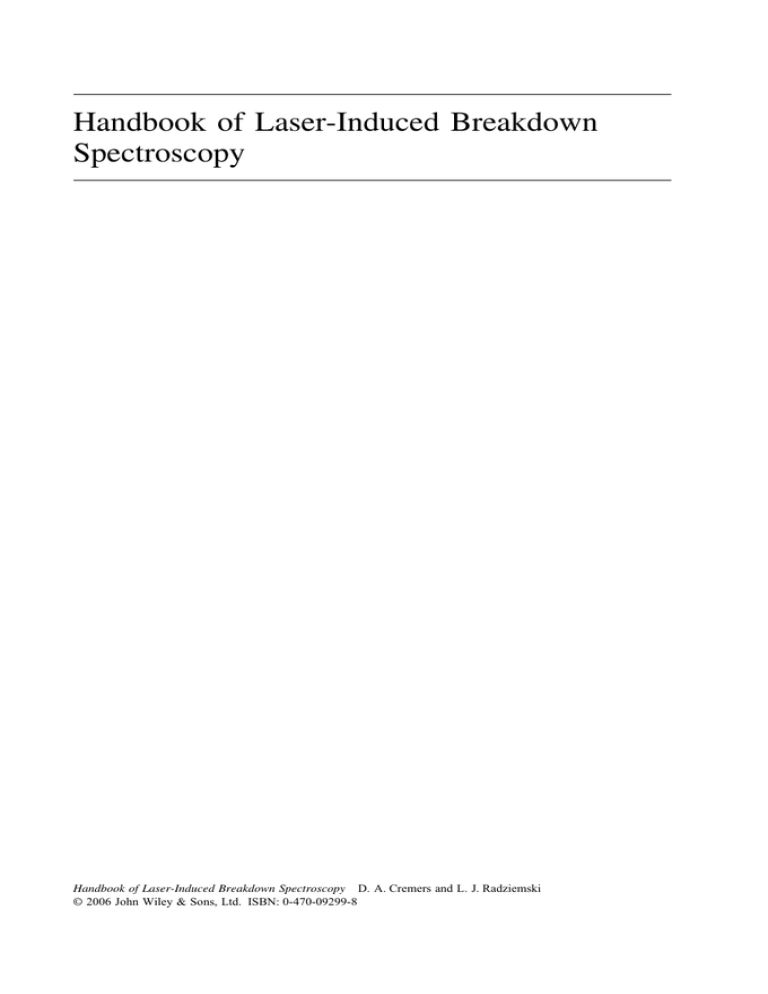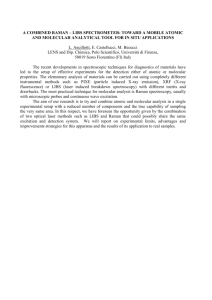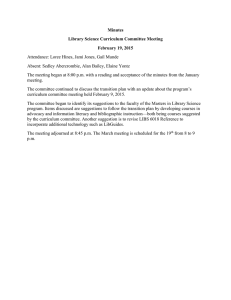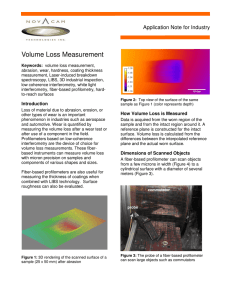
Handbook of Laser-Induced Breakdown
Spectroscopy
Handbook of Laser-Induced Breakdown Spectroscopy D. A. Cremers and L. J. Radziemski
© 2006 John Wiley & Sons, Ltd. ISBN: 0-470-09299-8
Handbook of
Laser-Induced
Breakdown
Spectroscopy
David A. Cremers
Applied Research Associates, Inc.
Albuquerque, NM
and
Leon J. Radziemski
Research Corporation
Tucson, AZ
Copyright © 2006
John Wiley & Sons Ltd, The Atrium, Southern Gate, Chichester,
West Sussex PO19 8SQ, England
Telephone
(+44) 1243 779777
Email (for orders and customer service enquiries): cs-books@wiley.co.uk
Visit our Home Page on www.wiley.com
All Rights Reserved. No part of this publication may be reproduced, stored in a retrieval system or
transmitted in any form or by any means, electronic, mechanical, photocopying, recording, scanning or
otherwise, except under the terms of the Copyright, Designs and Patents Act 1988 or under the terms of
a licence issued by the Copyright Licensing Agency Ltd, 90 Tottenham Court Road, London W1T 4LP,
UK, without the permission in writing of the Publisher. Requests to the Publisher should be addressed
to the Permissions Department, John Wiley & Sons Ltd, The Atrium, Southern Gate, Chichester,
West Sussex PO19 8SQ, England, or emailed to permreq@wiley.co.uk, or faxed to (+44) 1243 770620.
Designations used by companies to distinguish their products are often claimed as trademarks. All
brand names and product names used in this book are trade names, service marks, trademarks or
registered trademarks of their respective owners. The Publisher is not associated with any product or
vendor mentioned in this book.
This publication is designed to provide accurate and authoritative information in regard to the
subject matter covered. It is sold on the understanding that the Publisher is not engaged in
rendering professional services. If professional advice or other expert assistance is required, the
services of a competent professional should be sought.
Other Wiley Editorial Offices
John Wiley & Sons Inc., 111 River Street, Hoboken, NJ 07030, USA
Jossey-Bass, 989 Market Street, San Francisco, CA 94103-1741, USA
Wiley-VCH Verlag GmbH, Boschstr. 12, D-69469 Weinheim, Germany
John Wiley & Sons Australia Ltd, 42 McDougall Street, Milton, Queensland 4064, Australia
John Wiley & Sons (Asia) Pte Ltd, 2 Clementi Loop #02-01, Jin Xing Distripark, Singapore 129809
John Wiley & Sons Canada Ltd, 22 Worcester Road, Etobicoke, Ontario, Canada M9W 1L1
Wiley also publishes its books in a variety of electronic formats. Some content that appears in print
may not be available in electronic books.
Library of Congress Cataloging in Publication Data
Cremers, David A.
Handbook of laser-induced breakdown spectroscopy / David A. Cremers and Leon J. Radziemski.
p. cm.
Includes bibliographical references and index.
ISBN-13: 978-0-470-09299-6 (cloth : alk. paper)
ISBN-10: 0-470-09299-8 (cloth : alk. paper)
1. Atomic emission spectroscopy. 2. Laser spectroscopy. I. Radziemski, Leon J., 1937–
II. Title.
QD96.A8C74 2006
543 .52—dc22
2006006408
British Library Cataloguing in Publication Data
A catalogue record for this book is available from the British Library
ISBN-13 978-0-470-09299-6 (HB)
ISBN-10 0-470-09299-8 (HB)
Typeset in 10/12pt Times by Integra Software Services Pvt. Ltd, Pondicherry, India
Printed and bound in Great Britain by TJ International Ltd, Padstow, Cornwall
This book is printed on acid-free paper responsibly manufactured from sustainable forestry
in which at least two trees are planted for each one used for paper production.
To Tom Loree, scientist and colleague, who started the LIBS project at
Los Alamos National Laboratory in the late 1970s
Contents
Foreword
xi
Preface
xiii
Acronyms, Constants and Symbols
xvii
1 History
1.1 Atomic Optical Emission Spectrochemistry (OES)
1.1.1 Conventional OES
1.1.2 Laser OES
1.2 Laser-Induced Breakdown Spectroscopy (LIBS)
1.3 LIBS History 1960–1980
1.4 LIBS History 1980–1990
1.5 LIBS History 1990–2000
1.6 Active Areas of Investigation, 2000–2002
References
1
1
1
1
2
6
9
11
15
16
2 Basics of
2.1 LIBS
2.1.1
2.1.2
23
23
25
the LIBS Plasma
Plasma Fundamentals
Spectral Lines and Line Profiles
Determining Electron Densities from Spectral
Line Widths
2.1.3 Plasma Opacity
2.1.4 Temperature and Thermodynamic Equilibrium
2.2 Laser-Induced Breakdown
2.2.1 Breakdown in Gases
2.2.2 Post-Breakdown Phenomena in Gases
2.2.3 Breakdown In and On Solids, Aerosols
and Liquids
2.2.4 Post-Breakdown Phenomena on Solid Surfaces
2.3 Laser Ablation
2.4 Double or Multiple Pulse LIBS
2.5 Summary
References
3 Apparatus Fundamentals
3.1 Basic LIBS Apparatus
3.2 Lasers
27
30
31
36
36
39
39
41
43
47
49
50
53
53
54
viii
3.2.1 Laser Fundamentals
3.2.2 Types of Lasers
3.2.3 Properties of Laser Light Important for LIBS
3.2.4 Generation of Additional Wavelengths
3.2.5 Double Pulse Operation
3.3 Optical Systems
3.3.1 Focusing and Light Collection
3.3.2 Lenses
3.3.3 Fiber Optic Cables
3.4 Methods of Spectral Resolution
3.4.1 Introduction
3.4.2 Spectral Resolution Devices
3.5 Detectors
3.6 Detection System Calibrations
3.6.1 Wavelength Calibration
3.6.2 Spectral Response Calibration
3.7 Timing Considerations
3.8 Methods of LIBS Deployment
References
Contents
54
55
58
60
61
62
62
63
65
69
69
70
83
88
88
90
93
94
96
4 Determining LIBS Analytical Figures-of-Merit
4.1 Introduction
4.2 Basics of LIBS Measurements
4.3 Precision
4.4 Calibration
4.4.1 Calibration Curves
4.4.2 Calibration Standards
4.5 Detection Limit
4.6 Accuracy
References
99
99
99
105
107
107
113
115
115
116
5 Qualitative LIBS Analysis
5.1 Introduction
5.2 Identifying Elements
5.3 Material Identification
5.4 Process Monitoring
5.4.1 Experimental
5.4.2 Results
5.4.3 Conclusions
5.5 Material Sorting/Distinguishing
5.5.1 Surface Condition
5.5.2 Type of Analysis
5.5.3 Sorting Materials of Close Composition
5.6 Site Screening Using LIBS
References
119
119
119
122
125
126
127
133
133
134
134
136
137
141
Contents
ix
6 Quantitative LIBS Analysis
6.1 Introduction
6.2 Effects of Sampling Geometry
6.3 Other Sampling Considerations
6.4 Particle Size and Incomplete Vaporization
6.5 Use of Internal Standardization
6.6 Chemical Matrix Effects
6.7 Example of LIBS Measurement: Impurities in Lithium
Solutions
6.7.1 Objective
6.7.2 Experimental
6.7.3 Results
6.7.4 Discussion of Results
6.8 Reported Figures-of-Merit for LIBS Measurements
6.9 Conclusions
References
143
143
143
147
151
152
153
7 Remote LIBS Measurements
7.1 Introduction
7.2 Conventional Open Path LIBS
7.2.1 Apparatus
7.2.2 Focusing the Laser Pulse
7.2.3 Collecting the Plasma Light
7.2.4 Results Using Conventional LIBS
7.3 Stand-off LIBS Using Femtosecond Pulses
7.3.1 Conventional Remote LIBS Using Femtosecond
Laser Pulses
7.3.2 Remote Analysis by Femtosecond Pulse Produced
Filamentation
7.3.3 Teramobile
7.3.4 Remote LIBS Using Femtosecond Pulses
7.4 Fiber Optic LIBS
7.4.1 Fiber Optics for Light Collection
7.4.2 Fibers for Laser Pulse Delivery
7.4.3 Applications of Fiber Optics
References
171
171
173
173
174
178
179
182
8 Examples of Recent LIBS Fundamental Research, Instruments and
Novel Applications
8.1 Introduction
8.2 Fundamentals
8.3 Calibration-Free LIBS (CF-LIBS)
8.4 Laser and Spectrometer Advances
8.5 Surface Analysis
155
155
156
158
163
164
168
168
182
184
185
186
187
187
189
192
195
197
197
197
201
203
205
x
Contents
8.6 Double Pulse Studies and Applications
8.7 Steel Applications
8.8 LIBS for Biological Materials
8.9 Nuclear Reactor Applications
8.10 LIBS for Space Applications
References
Future of LIBS
Introduction
Expanding the Understanding and Capability of the LIBS Process
Widening the Universe of LIBS Applications
Factors that will Speed the Commercialization of LIBS
9.4.1 LIBS Standardization and Quantification
9.4.2 Routine LIBS use in Industrial Applications
9.4.3 Availability of Components and Systems
9.5 Conclusion
References
208
210
211
212
214
223
9 The
9.1
9.2
9.3
9.4
227
227
227
229
230
230
230
231
232
233
Appendix A Safety Considerations in LIBS
A.1 Safety Plans
A.2 Laser Safety
A.3 Generation of Aerosols
A.4 Laser Pulse Induced Ignition
References
237
237
237
238
239
239
Appendix B Recommended Methods for Commencing LIBS
Research on a Variety of Samples
References
241
243
Appendix C Representative LIBS Detection Limits
C.1 Detection Limits from the Literature
C.2 Uniform Detection Limits
References
245
245
263
265
Appendix D Major LIBS References
271
Index
275
Foreword
The most significant series of events occurring in the past four decades in the
field of analytical atomic spectroscopy have been the invention of the laser and
the development of array detectors. These events have led in the past 25 years
to the emergence of laser-induced breakdown spectroscopy (LIBS), also called
laser-induced plasma spectroscopy (LIPS), laser spark spectroscopy (LSS), and
laser optical emission spectroscopy (LOES). This technique has dominated the
analytical atomic spectroscopy scene in the last decade much like atomic absorption
spectroscopy dominated in the 1960–1970s, ICP atomic emission spectroscopy in
the 1970–1980s, and ICP mass spectrometry in the 1980–1990s. Certainly much of
the growth of LIBS as an analytical technique is directly attributed to the pioneering
research of Cremers and Radziemski. The 1981 papers by Radziemski and Loree
certainly began the revolution involving LIBS. The extreme interest in LIBS is
apparent when one looks at the rapid increase in publications since 1965, namely
fewer than 50/year from 1965 to about 1995 and since then the increase has been
nearly exponential with more than 100 in 1997, more than 200 in 1999, more than
300 in 2003, and about 400 in 2004. In addition, the interest in LIBS is obvious
when one looks at the number of LIBS sessions at PITTCON and FACSS and the
conferences devoted exclusively to LIBS.
Few analytical techniques other than LIBS have ever resulted in such a general
interest in the analytical community. Fundamental papers involving the measurement
of electron number densities and plasma temperatures; determination of the approach
to local thermodynamic equilibrium; the experimental and theoretical aspects of
laser breakdown in gases, liquids, solids and aerosols; the modeling of laser-induced
breakdown and ablation on solids; the modeling of post-breakdown of solids;
and the use of multiple laser pulses in LIBS have all occurred in the physics
and chemistry literature. The great attention to theoretical aspects of LIBS has
been fueled by numerous and far-reaching applications of LIBS. Applications have
involved solids, liquids, gases, and aerosols and specifically metals, environmental
particles, including aerosols, water contamination, archaeological studies, artwork
dating and cleaning, sampling of biological materials including bacteria and spores,
analyses during machining, and homeland security involving analysis of explosives
and biological and chemical warfare agents. The analytical interest has resulted
primarily because of the multi-element capability, the applicability to virtually all
sample types, the low sample requirements (almost non-destructive), the speed of
measurements, and the lack of sample preparation. The major difficulty with LIBS
involving calibration is a major current research area where calibration-free and
absolute analysis are active areas of research activity.
xii
Foreword
I look forward to the further development of LIBS during the next decade. This
book will certainly be useful to all researchers and will be useful to me in a field
that has captivated my interest in the past few decades.
Professor J.D. Winefordner
V.T. and Louise Jackson Professor of Chemistry
Graduate Research Professor
Head, Analytical Division
Department of Chemistry
University of Florida, Gainesville, Florida USA
Preface
DC on the left and LR on the right
The invention of the laser has resulted in many technological spin-offs. One that
has emerged as a field-deployable, analytical technique is laser-induced breakdown
spectroscopy (LIBS), also sometimes called laser-induced plasma spectroscopy
(LIPS) or laser spark spectroscopy (LSS). LIBS uses a low-energy pulsed laser
(typically tens to hundreds of millijoules per pulse) to generate a plasma which
vaporizes a small amount of the sample. Spectra emitted by the excited species,
mostly atoms, are used to develop quantitative and qualitative analytical information.
Targets have included gases, liquids, and aerosols, with an emphasis on solids.
Applications have been many and range from sampling iron and steel, soil for
contamination, metals used in nuclear reactors for degradation, artwork for dating,
xiv
Preface
teeth of mummies for evidence of water contamination in the past, and detection of
aerosols emitted from smokestacks or during machining operations. In the past five
years, new applications have sprung up around sampling of biological materials,
planetary exploration, and homeland security. Improved techniques are being
developed, and LIBS instrumentation is now available commercially. Experiments
have driven improved theoretical and computational models of plasma initiation and
expansion.
In the early 1980s there were few groups working on LIBS. In the past
decade, however, the field has expanded greatly with many international groups
now investigating and developing the method for a variety of applications. The
first international conference solely on LIBS was held in Pisa, Italy in 2000.
Subsequently, international meetings have been held every 2 years, and meetings
focused on work in the European and Mediterranean areas on the odd years.
Several edited books and book chapters published in the last decade and a half
provided snapshots of the status of LIBS at the time of their publication. Our goals
are somewhat different. In addition to a comprehensive update of the forefront of
LIBS development and applications, we review and summarize, for the novice, the
principles of plasma spectroscopy and analytical spectrochemistry as it applies to
LIBS. Included are new data and archival material to assist experienced as well as
new users. Embedded are comments on the many advantages of the method along
with its limitations, to provide the reader a balanced overview of LIBS capabilities.
In the first chapter we present a historical review of LIBS development through
to the year 2002, based on the peer-reviewed literature. We focus on the earliest
time an innovation or application appeared on the scene, rather than tracing every
development through to the present day. Of course, continuous improvements in
apparatus, techniques, and fundamental understanding drive the reexamination of
old applications, and the emergence of new applications spurs improvements in a
recurring spiral of progress. Chapter 2 contains a review of the basic principles of
plasma atomic emission spectroscopy. A plasma is a local assembly of atoms, ions
and free electrons, overall electrically neutral, in which the charged species often act
collectively. Natural light emitting plasmas, like the sun, have been known forever.
Electrically-induced plasmas have been generated in the laboratory since the 1800s,
and laser-induced plasmas have been investigated since the 1960s. In this chapter
we deal with the intricacies of LIBS plasma formation, lifetime and decay, in and
on a variety of media, focusing on spectral information as the primary diagnostic
technique. The use of spectral line properties for determining plasma properties
such as temperature and electron density is discussed. Laser ablation and the effect
of multiple laser pulses on plasma properties are also reviewed here.
LIBS uses instrumentation similar to that employed by other atomic spectroscopic
methods, and each important element of a LIBS apparatus is discussed in turn in
Chapter 3. The unique characteristics of LIBS originate from the use of a powerful
laser pulse to both ‘prepare’ the target sample and then ‘excite’ the constituent atoms
to emit light. To generate and capture those signals, a combination of modern laser,
detector, timing, and data-gathering instrumentation, with traditional spectroscopic
Preface
xv
apparatus including spectrometers and their optics is needed. New developments in
fiber optics and detector technology are highlighted. The calibration of wavelength
and spectral response is treated, along with methods of LIBS deployment from basic
set-ups to more advanced configurations.
The next three chapters deal with fundamental concepts in spectroscopic chemical
analysis and how they apply to and are modified by the conditions under which
LIBS operates. Analytical figures-of-merit are used to benchmark the capabilities of
an analysis method and to compare the performance of distinct analytical techniques
using a common set of parameters. These include limits of detection, precision,
accuracy, sensitivity and selectivity. In Chapter 4 we present a discussion of the more
important figures-of-merit and how they are used to characterize LIBS. The basic
element of any LIBS measurement is the emission spectrum recorded from a single
plasma. Each firing of the laser atomizes a portion of the sample in the focal volume
and produces a plasma that excites and re-excites the atoms to emit light. This is
then applied either to qualitative analysis as discussed in Chapter 5, or quantitative
measurements as presented extensively in Chapter 6. In the former, some basic
and practical methods of element and material identification are presented. In the
latter, we discuss the ultimate goal, to provide a highly quantitative analysis, hence
to determine with high precision and accuracy the concentration of a species in a
sample or the absolute mass of a species. We treat how LIBS interacts with different
forms of samples, internal standardization and matrix effects. A detailed example
of measuring impurities in a lithium solution is presented.
The ability to make remote measurement in field environments is one of the
principal advantages of LIBS. This application and three basic techniques for its use
are treated in Chapter 7. In the first method, the laser beam is directed over an open
path (through air, gas or vacuum) to the target on which a plasma is formed, and
then the plasma light is collected at a distance. In the second method, the laser pulses
are injected into a fiber optic and transported to the remotely located target sample,
while in the third method, a compact probe containing a small laser is positioned
next to the remotely located sample and the plasma light is sent back to the detection
system over a fiber optic cable. We discuss subjects such as conventional stand-off
analysis, the development of very long distance analysis, and details of the physics
and engineering of fiber optics.
In Chapter 8 we consider the recent history from 2003 on, emphasizing the
latest trends in LIBS research and applications, and focusing on what a new applier
of LIBS needs to know to perform state-of-the-art LIBS experiments. Subjects
reviewed include fundamentals enhanced by modeling and experiments, double
pulse studies and applications to nuclear reactors and detection of biological agents.
The chapter ends with a detailed review of the progress towards sending LIBS
on a mission to Mars. A book on LIBS would not be complete without some
speculations on the most promising directions for the future, methods of expanding
LIBS applications, and factors that will speed its commercialization. These are the
subjects of Chapter 9.
The appendices contain fundamental information that will be useful to the
LIBS community. They include: (A) a discussion of the essentials of basic safety
xvi
Preface
considerations for LIBS operations; (B) a guide for getting a quick start in LIBS
development; (C) published detection limits, as well as a unique list of element
detection limits using a uniform method of analysis developed for this text, and (D)
a list of major LIBS references.
Starting from fundamentals and moving through a thorough discussion of
equipment, methods, and applications, we believe that the Handbook of LaserInduced Breakdown Spectroscopy will provide a unique reference source that will
be of value for many years for this important new analytical technique.
David Cremers
Leon Radziemski
Acronyms, Constants and Symbols
Item
Definition
Value, units, or comments
absorption coefficient as a function
of wavelength
acousto-optic tunable filter
avalanche photodiode
speed of light in vacuum
charge coupled device
/cm
AOTF
APD
c
CCD
COD
CF-LIBS
CW
CRM
e
eV
FOC
FOM
continuous optical discharge
calibration-free LIBS
continuous wave
certified reference material
electron charge
electron volt
emissivity as a function of
wavelength
electric constant
f-number of an optical system (e.g.
lens or spectrograph)
fiber optic cable
figures-of-merit
FWHM
full-width at half maximum
full-width at half maximum
intensity of a spectral line
half-width at half maximum
o
f#
HWHM
h
ICCD
ICP
IPDA
IR
k
LIBS
LIDAR
Planck constant
Planck constant/2
intensified CCD array
inductively coupled plasma
intensified PDA
infra-red
Boltzmann constant
laser-induced breakdown
spectroscopy
Light detection and ranging
LIPS
LIF
laser-induced plasma spectroscopy
laser-induced fluorescence
Chapter 3
a sensitive photodiode type detector
299 792 458 m/s
two dimensional array of photodiodes,
Chapter 3
Chapter 8
used to calibrate LIBS, Chapter 4
160217653 × 10−19 C
160217653 × 10−19 J
8854187817 × 10−12 Farads/m
e.g. f# = f/d = (lens focal length) / (lens
diameter)
Chapter 3
a set of parameters to benchmark the
performance of an analytical method,
Chapter 4
width of a spectral line at the points of
half maximum intensity
units of wavelength, wavenumber or
frequency
half width of a spectral line at the points
of half maximum intensity
66260693 × 10−34 J/s
10545717 × 10−34 J/s
Chapter 3
Chapter 3
refers to a spectral region, > 700 nm
13806505 × 10−23 J/K
optical methods of remote sensing of
materials in the atmosphere
alternate name for the LIBS method
xviii
Acronyms, Constants and Symbols
(Continued)
Item
Definition
Value, units, or comments
LOD
LOQ
LSC
LSD
LSR
LSS
LTE
LTSD
m
MCP
NA
Nd:YAG
limit of detection
limit of quantification
laser-supported combustion
laser-supported detonation
laser-supported radiation
laser spark spectroscopy
local thermodynamic equilibrium
lens-to-sample distance
wavelength
electron mass
multichannel plate
numerical aperture
neodymium YAG laser
Chapter 4
Chapter 4, LOQ = 3.3LOD, usually
type of plasma wave, Chapter 2
type of plasma wave, Chapter 2
type of plasma wave, Chapter 2
alternate name for the LIBS method
Chapter 2
NIR
OES
PCA
PD
PDA
PMT
ppm
ne
R-FIBS
RSD
RM
s
T
tb
near IR
optical emission spectroscopy
principal component analysis
photodiode
photodiode array
photomultiplier tube
parts-per-million
frequency
electron density
remote filament induced
breakdown spectroscopy
relative standard deviation
reference material
wavenumber
standard deviation
Absolute temperature
gate width
td
delay time
Torr
UV
VIS
VUV
XRF
unit of pressure
ultraviolet
visible
vacuum ultraviolet
x-ray fluorescence
nm, angstroms (Å); 1Å = 01 nm
91093826 × 10−31 kg
intensifier for a CCD and PDA, Chapter 3
type of solid state laser typically used for
LIBS
refers to a spectral region, 700 < < 3000 nm
solid state optical detector, Chapter 3
one-dimensional array of photodiodes
optical detector
concentration unit, usually stated as w/w
Hz
/cm3
Chapter 7
Chapter 4
used to calibrate LIBS, Chapter 4
/cm
Chapter 4
degrees Kelvin (K)
time period over which the plasma light is
recorded
time period between arrival of the laser pulse
at the sample to form the plasma and the
start of recording of the plasma light signal
refers to a spectral region, 180 < < 400 nm
refers to a spectral region, 400 < < 700 nm
refers to a spectral region, < 180 nm
method of element detection
Values from P.J. Mohr and B.N. Taylor (2005). CODATA recommended values of the fundamental constants: 2002.
Rev. Mod. Phys. 77: 1–108.







